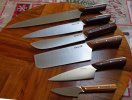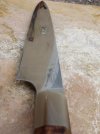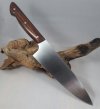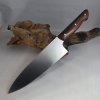Hello everyone,
First, I want to thank everyone for all the great info on this site - just getting into this hobby, there is so much to learn by reading everything here.
My main interest is working on kitchen knives, and I am getting better at the initial grinding, but I was curious how people went about finishing their work.
Right now, I go 60->120 on the belt, then to 120 on the disk to fix any issues in the bevels. Then, I go A65->A45->A30 on the trizact belts, followed by a very fine scotchbrite belt.
That leaves a nice machine finish, I've also gone back and hand sanded that, starting from 320 -> 600, and that works well for me too
Here is a picture of my most recent knife, on this one I was experimenting with how far I could take different scotchbrite belts, so the finish isn't that great - the profile and handle are my favorite so far though.

First, I want to thank everyone for all the great info on this site - just getting into this hobby, there is so much to learn by reading everything here.
My main interest is working on kitchen knives, and I am getting better at the initial grinding, but I was curious how people went about finishing their work.
Right now, I go 60->120 on the belt, then to 120 on the disk to fix any issues in the bevels. Then, I go A65->A45->A30 on the trizact belts, followed by a very fine scotchbrite belt.
That leaves a nice machine finish, I've also gone back and hand sanded that, starting from 320 -> 600, and that works well for me too
Here is a picture of my most recent knife, on this one I was experimenting with how far I could take different scotchbrite belts, so the finish isn't that great - the profile and handle are my favorite so far though.













